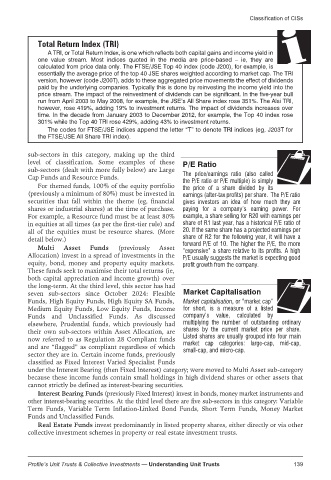Page 141 - Profile's Unit Trusts & Collective Investments - March 2025
P. 141
Classification of CISs
Total Return Index (TRI)
A TRI, or Total Return Index, is one which reflects both capital gains and income yield in
one value stream. Most indices quoted in the media are price-based – ie, they are
calculated from price data only. The FTSE/JSE Top 40 index (code J200), for example, is
essentially the average price of the top 40 JSE shares weighted according to market cap. The TRI
version, however (code J200T), adds to these aggregated price movements the effect of dividends
paid by the underlying companies. Typically this is done by reinvesting the income yield into the
price stream. The impact of the reinvestment of dividends can be significant. In the five-year bull
run from April 2003 to May 2008, for example, the JSE’s All Share index rose 351%. The Alsi TRI,
however, rose 419%, adding 19% to investment returns. The impact of dividends increases over
time. In the decade from January 2003 to December 2012, for example, the Top 40 index rose
301% while the Top 40 TRI rose 429%, adding 43% to investment returns.
The codes for FTSE/JSE indices append the letter “T” to denote TRI indices (eg, J203T for
the FTSE/JSE All Share TRI index).
sub-sectors in this category, making up the third
level of classification. Some examples of these P/E Ratio
sub-sectors (dealt with more fully below) are Large The price/earnings ratio (also called
Cap Funds and Resource Funds.
the P/E ratio or P/E multiple) is simply
For themed funds, 100% of the equity portfolio the price of a share divided by its
(previously a minimum of 80%) must be invested in earnings (after-tax profits) per share. The P/E ratio
securities that fall within the theme (eg, financial gives investors an idea of how much they are
shares or industrial shares) at the time of purchase. paying for a company’s earning power. For
For example, a Resource fund must be at least 80% example, a share selling for R20 with earnings per
in equities at all times (as per the first-tier rule) and shareofR1lastyear, hasahistoricalP/E ratioof
all of the equities must be resource shares. (More 20. If the same share has a projected earnings per
detail below.) shareofR2for thefollowing year,itwillhavea
forward P/E of 10. The higher the P/E, the more
Multi Asset Funds (previously Asset “expensive” a share relative to its profits. A high
Allocation) invest in a spread of investments in the P/E usually suggests the market is expecting good
equity, bond, money and property equity markets. profit growth from the company.
These funds seek to maximise their total returns (ie,
both capital appreciation and income growth) over
the long-term. At the third level, this sector has had
seven sub-sectors since October 2024: Flexible Market Capitalisation
Funds, High Equity Funds, High Equity SA Funds, Market capitalisation, or “market cap”
Medium Equity Funds, Low Equity Funds, Income for short, is a measure of a listed
Funds and Unclassified Funds. As discussed company’s value, calculated by
elsewhere, Prudential funds, which previously had multiplying the number of outstanding ordinary
their own sub-sectors within Asset Allocation, are shares by the current market price per share.
now referred to as Regulation 28 Compliant funds Listed shares are usually grouped into four main
market cap categories: large-cap, mid-cap,
and are “flagged” as compliant regardless of which small-cap, and micro-cap.
sector they are in. Certain income funds, previously
classified as Fixed Interest Varied Specialist Funds
under the Interest Bearing (then Fixed Interest) category; were moved to Multi Asset sub-category
because these income funds contain small holdings in high dividend shares or other assets that
cannot strictly be defined as interest-bearing securities.
Interest Bearing Funds (previously Fixed Interest) invest in bonds, money market instruments and
other interest-bearing securities. At the third level there are five sub-sectors in this category: Variable
Term Funds, Variable Term Inflation-Linked Bond Funds, Short Term Funds, Money Market
Funds and Unclassified Funds.
Real Estate Funds invest predominantly in listed property shares, either directly or via other
collective investment schemes in property or real estate investment trusts.
Profile’s Unit Trusts & Collective Investments — Understanding Unit Trusts 139

